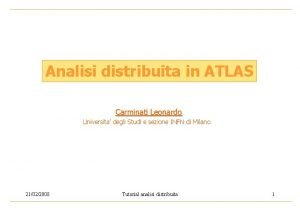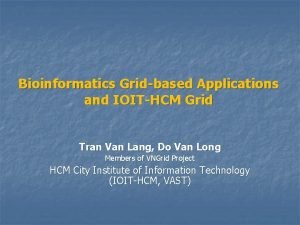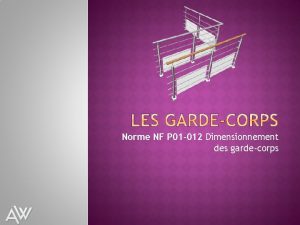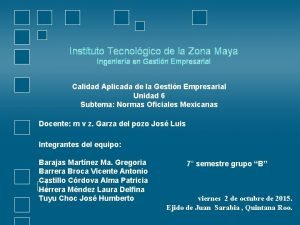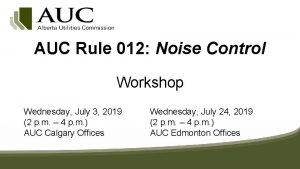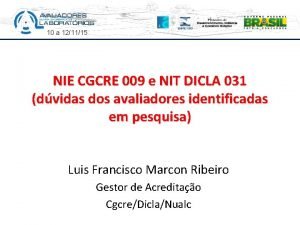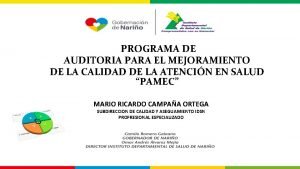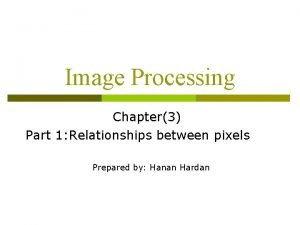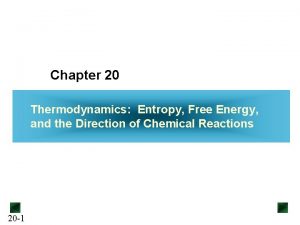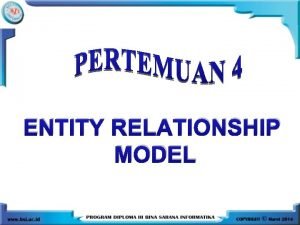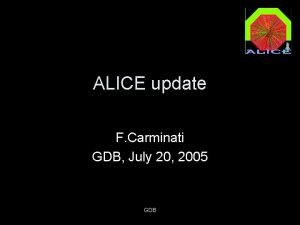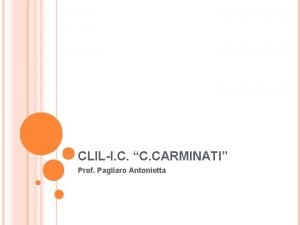T 012 to T 012 relationship F Carminati












- Slides: 12

T 0/1/2 to T 0/1/2 relationship F. Carminati June 12, 2006 T 2 workshop@CERN

ALICE computing model • For pp similar to the other experiments – – • For AA different model – – – • • • Quasi-online data distribution and first reconstruction at T 0 Further reconstructions at T 1’s Calibration, alignment, pilot reconstructions and partial data export during data taking Data distribution and first reconstruction at T 0 in the four months after AA run (shutdown) Further reconstructions at T 1’s T 0: First pass reconstruction, storage of RAW, calibration data and first-pass ESD’s T 1: Subsequent reconstructions and scheduled analysis, storage of a collective copy of RAW and one copy of data to be safely kept, disk replicas of ESD’s and AOD’s T 2: Simulation and end-user analysis, disk replicas of ESD’s and AOD’s 2

Relations T 1 – T 2 • In the ALICE Computing TDR there are no particular relations among Tier 1 and Tier 2 sites • All sites of each category share their tasks – Reconstruction, scheduled analysis, and unscheduled analysis and Monte-Carlo production • Relations T 2 and T 1 are in terms of data storage – MC data and AOD from unscheduled analysis produced at T 2 are shipped to the “closest” T 1 for custodial storage • In countries with a T 1, T 2’s in the country refer to it – This is the case in France, Germany and Italy • In other countries, the T 1 should ideally be the one with the best bandwidth 3

Relations T 1 – T 2 • The main question is the impact in terms of storage @ T 1’s and network resources • We have estimated it using only MC data, which provide the bulk of data at Tier 2 • Available resources, pledged so far to ALICE, only allow producing about 50% of the MC data required by our Computing Model • Storage and bandwidth, assuming that all T 2’s absorb proportionally the 50% deficit 4

Disclaimer • During the Rome GDB it was asked to experiments to provide the T 2 -T 1 relationships • ALICE said that it would have preferred LCG to handle the first version of the table – But this task was pushed back on experiments • We have now a tentative table, however – It does not follow from our computing model – It allows however to solidify the relations T 2 – hosting T 1 5

Analysis of first data in 2007 6

PDC’ 06 progress and plans • Production of p+p and Pb+Pb events – Conditions and samples agreed with PWGs – Data migrated to CERN – Duration – 30 -45 days (ongoing) • Push-out to T 1 s (through FTS) - July • Registration of RAW data -> first pass reconstruction at CERN -> secon pass reconstruction at T 1 s – August/September • User analysis on the GRID and at CAF – September/October 7

Grid software deployment and running • LCG sites are operated through the VO-box framework (see talk of Patricia) – All ALICE sites should provided one – Relatively extended deployment cycle, a lot of configuration and versioning issues had to be solved – Situation is quite routine now • Data management – This year – xrootd as disk pool manager on all site SEs – The installation/configuration procedures have just been released – xrootd integrated in other storage management solutions (CASTOR, DPM, d. Cache) – under development • Data replication (FTS) – Lower-level service for p-2 -p data transfers – We use it for scheduled replication of data between the computing centres (RAW from T 0 ->T 1, MC production T 2 ->T 1, etc…) – Fully incorporated in the Ali. En FTD, to be extensively tested in July 8

VO box support and operation • In additional to the standard LCG components, the VO-box runs ALICE-specific software components • The installation and maintenance of these is entirely our responsibility: – Regional principle, few named experts handling the installation and support (alicesgm), emphasis on overlap and redundancy: • • • CERN – Pablo Saiz (also Ali. En expertise), Patricia Mendez Lorenzo, Latchezar Betev Italy – Stefano Bagnasco France – Artem Trunov, Jean-Michel Barbet (Subatech Nantes) Germany – Kilian Schwarz, Jan-Fiete Grosse Oetringhaus (Muenster) Russia – Mikalai Kutouski, Eygene Ryabinkin Romania – Claudiu Shiaua All others (NIKHEF, SARA, RAL, US) - Patricia Mendez Lorenzo, Latchezar Betev We wish to enlarge this list with more experts (if they become available) Installation, maintenance and operation procedures are quite well documented (major effort by the Ali. En team and Stefano) • Site related problems are handled by the site admins • LCG services problems are reported to GGUS 9

Conclusions and outlook • The last exercise before data taking (PDC’ 06) has started as planned – T 2 s are playing an important role in its operation – both in terms of resources and services testing – It is a test of all Grid tools/services we will use in 2007 • If not in PDC’ 06, good chance is that they will not be ready – It is also a large-scale test the computing infrastructure – computing, storage and network performance 10

Conclusions and outlook (2) • We have (some untested) all pieces needed to run production on the Grid • The exercise has started 1 ½ months ago and will continue until the end of the year • At the moment, we are optimizing the use of resources, improving the stability of services at all sites • Next phase of the plan is a test of the file transfer utilities of LCG (FTS) and integration with Ali. En FTD • Finally we will do the most difficult task – analysis on the GRID 11

12
 Leonardo carminati
Leonardo carminati Relationship management vs relationship marketing
Relationship management vs relationship marketing Ioit-012
Ioit-012 Norme nfp 01-012
Norme nfp 01-012 Nom-012-scfi-1994
Nom-012-scfi-1994 Auc rule 012
Auc rule 012 Zabiegi sanitarne
Zabiegi sanitarne Doq-cgcre-020
Doq-cgcre-020 Circular 012 pamec excel
Circular 012 pamec excel Adjacency in image processing examples
Adjacency in image processing examples Enthalpy entropy free energy
Enthalpy entropy free energy Module 4: investing test answer key
Module 4: investing test answer key The symbiotic relationship between pt
The symbiotic relationship between pt
